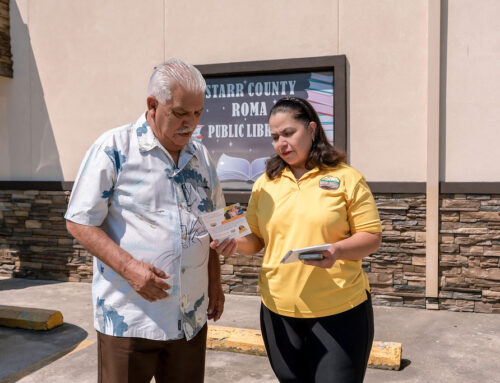Six Tips for CHW Supervision Success
There is no question that the Community Health Worker (CHW) movement expanded its profile in 2015. From the front lines of the Ebola fight abroad to the constant changes in health care reform here at home, the profession gained profile, utility and respect.
Less prominent, but equally important, has been the growing role of the CHW supervisor. Supervisors are an indispensable component of the CHW profession that requires as much attention, care and training as the CHWs themselves receive.
With more than 30 years’ experience designing, running, evaluating and improving CHW programs, as well as more than 20 years’ experience spreading that knowledge via technical assistance to other organizations around the country, MHP Salud has gained insight, experience and a deep understanding of CHW supervision.
Much of this year was spent traveling the country sharing this information at trainings, meetings and conferences. Staff travelled from North Carolina’s Outerbanks to the Pacific Northwest leading hands-on trainings for supervisors. The Capacity-Building Assistance team shared supervision workshops at Stream Forums across the country. Chief Strategy and Analytics Officer Ashley Martin and Chief Programming Officer Colleen Reinert presented at an American Public Health Association Learning Institute on the subject, and the organization released tools, resources and brief reports to help people learn about CHW supervision.
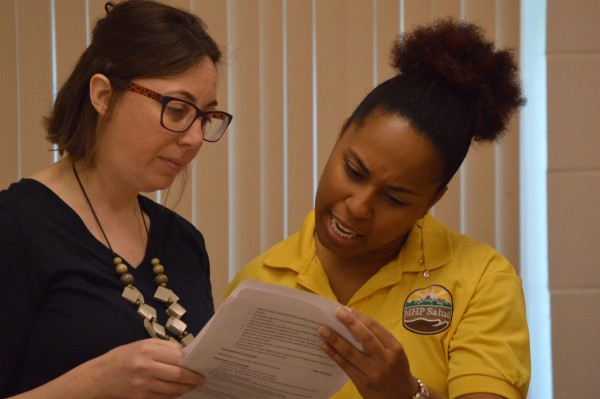
From all our experience in 2015, we collected this list of six tips for supervision success, which includes insights from MHP Salud staff who supervise CHWs every day. These six tips can be used to strengthen, solidify and promote the CHW model through the professional development of their supervisors.
1. Not everyone is right for the role.
Just as CHWs must possess innate qualities and life experiences to be successful, their supervisors need some baseline skills and qualities as well.
First, if a CHW supervisor is working with a population that is multilingual, the supervisor must have the ability to communicate in the language used by the CHWs he or she supervises. Additionally, in order to read the landscape of the community served, he or she should have a strong knowledge, understanding of or experience with its culture.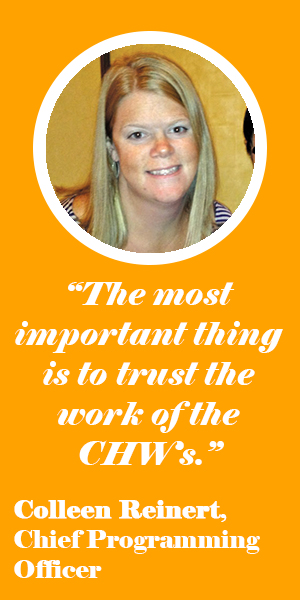
Solid time management and independent working skills are also vital to serve as an effective CHW supervisor. Much of a program manager’s day is spent juggling CHW supervision, reporting to funders and the organization and attending local meetings in order to maintain community partnerships and relationships. These broad responsibilities are only effectively met through careful planning and an ability to prioritize independent work.
Apart from life experience and skills, MHP Salud’s Chief Programming Officer Colleen Reinert says there are some innate characteristics needed.
“In relation to specifically supervising the CHWs,” she said, “I would say the most important thing is to trust the work of the CHWs.”
To maximize their impact, CHWs spend much of their time away from the supervisor out in the fields. Because of this, neither role will function if a supervisor constantly checks that the CHWs are doing what they said they would be doing. Regular check-ins and management tools are still necessary in CHW supervision, but without trust, no one will be able to get their work done.
Reinert says flexibility is also key.
“The work of CHWs is not necessarily a nine-to-five job,” she said, “so a supervisor has to also be flexible in the work that their CHWs are doing.”
For example, CHWs may not be able to come into the office at a set time in the morning if they stayed out late the night before at a health fair event. The CHWs are inherently flexible around the schedule of the community they serve, and the supervisor must mimic this flexibility.
2. It’s different from other supervisory roles.
Apart from the other organizational requirements for employees, Reinert says a good CHW supervisor needs to be able to recruit quality CHWs. This requires an ability to spot those characteristics that make a CHW successful: compassion, trustworthiness, empathy and the abilities to motivate other individuals and navigate the health system and social services.
“Identifying these things isn’t something you can learn at school or receive training on,” said Reinert.
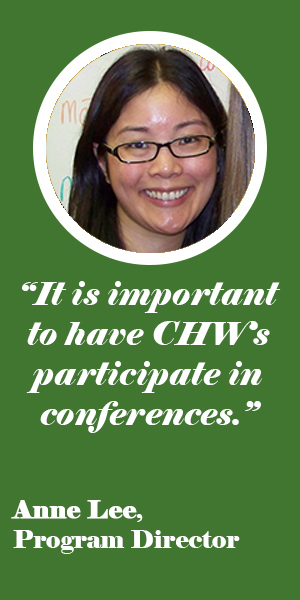 Once hired, measuring and understanding the CHWs’ performance requires additional specialized skills and experience. Good supervision might include holding team and individual meetings to grasp the realities on the ground in the communities served and the CHWs’ impact on it.
Once hired, measuring and understanding the CHWs’ performance requires additional specialized skills and experience. Good supervision might include holding team and individual meetings to grasp the realities on the ground in the communities served and the CHWs’ impact on it.
“In another position, effective work might be monitored via sales, or number of phone calls, but in CHW programs, there might not be something so concrete,” said Reinert. “It’s more of an art and less of a science.”
CHW supervision hinges on the supervisor understanding that even though a CHW’s impact may not be as clearly legible as other roles in the health care field, a good supervisor will seek to understand this impact through trust and the ability to listen.
“Something I have seen over the years is, as much as CHWs appreciate support and seek support, they’re also generally not very willing to express concern when they’re not receiving the support that’s needed,” said Reinert.
She says it is important for managers and upper managers to remember to ensure that there is that time or environment to allow the CHWs to express their needs or concerns that they have within the community and within their organization.
3. Good CHW supervisors champion the work of their staff.
As the CHW movement is expanding and being applied in a larger variety of organizations, health care systems and federal governments, it will be key to find ways for both CHWs and their supervisors to maintain the integrity of the CHW profession.
“I don’t want to see it turn into something that it’s not,” said Reinert. “Supervisors have a huge role in ensuring that that doesn’t happen.”
To successfully do this, the supervisor must understand the work of a CHW. They may have been a CHW themselves. If not, they need to have spent enough time getting to know the work of a CHW so that they can appreciate the unique role CHWs play and the challenges and successes that come with that role.
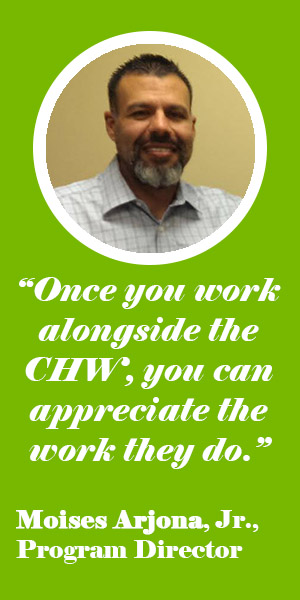 It is also important that supervisors advocate for their CHWs—both internally and externally.
It is also important that supervisors advocate for their CHWs—both internally and externally.
Within some organizations, like MHP Salud, who are wholly focused on and invested in the CHW model, advocating for the role of their staff may not be a challenge. In others, such as hospital systems, CHW program services may be a small component of the organization’s work. In these cases, the rest of the employees may lack a full understanding of what a CHW is actually doing, and it is often up to the supervisor to educate them.
Supervisors are also key in promoting the CHW professional movement outside of their own organization.
“It is important to have CHWs participate in conferences, whether to present on their own program, to network or to gain more professional development,” said Capacity-Building Assistance Program Director Anne Lee.
Experienced supervisors who understand the CHW point of view can also amplify that viewpoint in group-settings to ensure that the CHW voice is heard.
Instinto Maternal Program Director Randi McCallian says she has learned that supervising CHWs is about more than simply ensuring a job gets accomplished.
“As a supervisor, I try to remember that my role is two-fold,” said McCallian, “to reach program goals and ensure fidelity to the program plan, but to also allow for the professional growth and experience of those I supervise.”
4. There is more than one way to run and supervise a program.
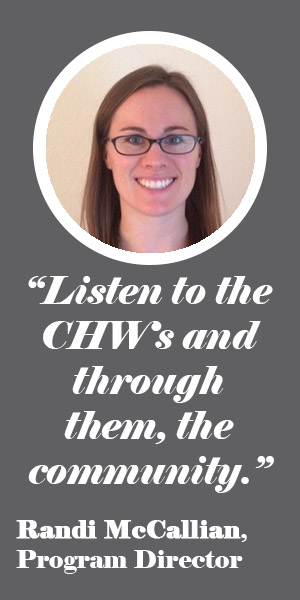 As the profession grows, it is increasingly common for programs to employ CHWs with varying levels of responsibilities. A multi-tiered model is used to distribute the responsibilities of CHWs based on the time commitment and expectations of their position, which can range from a part-time volunteer to a full-time staff member.
As the profession grows, it is increasingly common for programs to employ CHWs with varying levels of responsibilities. A multi-tiered model is used to distribute the responsibilities of CHWs based on the time commitment and expectations of their position, which can range from a part-time volunteer to a full-time staff member.
When used effectively, this model allows a program to maximize resources, extend the reach of CHWs and create a greater program impact.
“Regardless of the CHW tier,” said Reinert, “what’s important to remember is that all CHWs still require a supervisor, coach or mentor—somebody providing support.”
Just as program form can vary, so can the communication between supervisors and their CHWs. With recent advances in technology, it is easy to have proper communication with the CHWs if they receive appropriate tools.
“Several years ago, it could have been that a supervisor sends an email a CHW, and it took a week for the CHW to get access to the email in order to respond,” said Reinert.
These days, especially if an organization can provide proper communication to a CHW, such as a smartphone and internet services, it’s possible for a CHW to remain in the field and communicate with their supervisor remotely a majority of the time.
Though Colonia Community Project Program Director Moises Arjona, Jr. spends the majority of his time supervising CHWs remotely while they provide door-to-door outreach in the field, he finds it invaluable to change up his supervisory style occasionally and shadow his staff in the field in order to understand the realities of their work up close.
“Once you actually work alongside the CHWs, you can appreciate the work that they do and see the barriers they encounter,” he said. “For example, I saw what it was like to go along door-to-door and have the door closed in my face constantly.”
5. Initial plans don’t always pan out, and that’s okay.
With more and more health agencies adopting CHW programs of their own as a way to address social determinants of health, lofty program objectives are sometimes hampered by realities on the ground.
“Often, a development team has designed a program with goals and expectations,” said Reinert, “but when the program begins, and the CHWs are out on the ground doing their work, the numbers that the development team originally identified are unrealistic.”
Supervisor flexibility comes into play in these instances. Otherwise, if a supervisor continues to push a team of CHWs to meet those goals without making accommodations for the reality of the situation, the CHWs could burn out.
To prevent this, supervisors must be able to listen to their staff to understand the barriers they encounter in the community, so that they can adapt their goals, bring on more staffing or work together to find a solution to a problem.
Instinto Maternal Program Director Randi McCallian says she’s learned that listening is key to revising expectations and solving problems.
“Listen to the CHWs and through them, the community,” she said. “CHWs have a close relationship and understanding of the strengths and needs of a community, so if anything needs to be addressed, their input on strategies that will work is invaluable.”
6. Support is out there.
Currently, there are more opportunities than ever for CHW supervisors to develop their work. Local, state and national CHW associations, conferences and other meetings provide supervisors a chance to network with others in the field in order to receive peer support and learn from best practices.
“Supervisory trainings and identifying available CHW supervision resources are very beneficial to organizations that have CHWs,” said Reinert. “It’s extremely important to the success of the CHWs and to that of the program.”
About MHP Salud
MHP Salud has over thirty years of experience implementing CHW programs and training organizations looking to start and/or strengthen their own CHW programs. For more information about MHP Salud, our services, and how we can help you, please email us at info@mhpsalud.org



